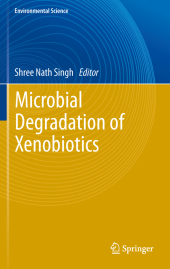 Neuerscheinungen 2013Stand: 2020-01-07 |
Schnellsuche
ISBN/Stichwort/Autor
|
Herderstraße 10
10625 Berlin
Tel.: 030 315 714 16
Fax 030 315 714 14
info@buchspektrum.de |

Shree Nath Singh
Microbial Degradation of Xenobiotics
Herausgegeben von Singh, Shree Nath
2012. 2013. xiv, 486 S. 90 SW-Abb.,. 235 mm
Verlag/Jahr: SPRINGER, BERLIN 2013
ISBN: 3-642-26983-4 (3642269834)
Neue ISBN: 978-3-642-26983-7 (9783642269837)
Preis und Lieferzeit: Bitte klicken
This book covers breakthroughs in sequencing methodology which offer new insight into metabolic and regulatory networks, as well as clues to the evolution of degradation pathways and to molecular adaptation strategies to changing environmental conditions.
Our interest in the microbial biodegradation of xenobiotics has increased many folds in recent years to find out sustainable ways for environmental cleanup. Bioremediation and biotransformation processes harness the naturally occurring ability of microbes to degrade, transform or accumulate a wide range of organic pollutants. Major methodological breakthroughs in recent years through detailed genomic, metagenomic, proteomic, bioinformatic and other high-throughput analyses of environmentally relevant microorganisms have provided us unprecedented insights into key biodegradative pathways and the ability of organisms to adapt to changing environmental conditions. The degradation of a wide spectrum of organic pollutants and wastes discharged into the environment by anthropogenic activities is an emerging need today to promote sustainable development of our society with low environmental impact. Microbial processes play a major role in the removal of recalcitrant compounds taking advantage of the astonishing catabolic versatility of microorganisms to degrade or transform such compounds. New breakthroughs in sequencing, genomics, proteomics, bioinformatics and imaging are generating vital information which opens a new era providing new insights of metabolic and regulatory networks, as well as clues to the evolution of degradation pathways and to the molecular adaptation strategies to changing environmental conditions. Functional genomic and metagenomic approaches are increasing our understanding of the relative importance of different pathways and regulatory networks to carbon flux in particular environments and for particular compounds. New approaches will certainly accelerate the development of bioremediation technologies and biotransformation processes in coming years for natural attenuation of contaminated environments
Biodegradation of Aromatic Pollutants by Ligninolytic Fungal Strains.- Microbial Degradation of Polychlorophenols.- Biodegradation of the Explosives TNT, RDX and HMX.- Biodegradation of Military Explosives Rdx and Hmx.
From the reviews:
"The book has the merit to compile the latest knowledge on microbial degradation covering a large range of pollutants that are not usually presented together. It is thus one of the rare books that provide a large image of the microbial metabolism potential for xenobiotic degradation. ... the book is of great interest, useful, and would be core reading for researchers and students exploring the microbial degradation capacities." (Robert Duran, Environmental Science and Pollution Research, Vol. 39, 2012)


